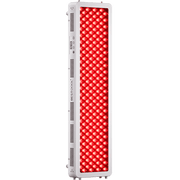What is Red Light Therapy?
Red light therapy (RLT) is a non-invasive therapy that applies certain wavelengths of red and near-infrared light, which stimulate major cellular processes of the body by photobiomodulation. RLT enhances mitochondrial function within cells, crucial for energy generation. RLT increases the rate of healing, decreases inflammation, and promotes skin health.
The common applications of red light therapy include:
Pain Management: RLT effectively diminishes pain and inflammation, making it sought-after for chronic pain sufferers.
Wound Healing: RLT can shorten the post-injury recovery duration by regenerating cells and reducing inflammation.
Skin Rejuvenation: RLT boasts anti-aging effects, such as improving skin texture, smoothing wrinkles, and treating acne.
How Red Light Therapy Can Help New Mothers?
RLT has become a growing interest among postpartum women due to its possible benefits after childbirth. Numerous new mothers face challenges adapting to the extensive physical and emotional demands after giving birth, including recovering from C-sections, experiencing hair loss, and developing stretch marks.
Wound healing after C-section
RLT can help in the healing process for mothers who have gone through a cesarean section. It can accelerate recovery and possibly improve the appearance of surgical scars by stimulating cellular regeneration and reducing inflammation. This could be important for mothers seeking restoration of their skin health and appearance.
Hair Loss
Postpartum hair loss is a frequent issue linked to hormonal shifts. It has been observed that RLT supports the growth of hair through increased blood flow and cellular activities related to the scalp. Thus, new mothers may use it as an option for restoring hair growth.
Stretch Marks
Pregnancy-induced physical transformations often lead to stretch marks, which many mothers hope to eliminate. RLT may maintain skin elasticity, thus reducing the likelihood of stretch marks. This is a non-invasive method, and mothers can easily take care of their skin without going through invasive procedures.
Red Light Therapy and Breastfeeding Safety
As postpartum women explore the benefits of RLT, safety during breastfeeding becomes a key concern. Breastfeeding mothers typically exercise caution when considering new treatments that might impact their own or their baby’s health. The potential impact of RLT on breast milk composition remains a significant worry for nursing women. The concern for many mothers is that exposure to light energy can affect the nutritional quality or safety of their milk along with the production of heat, especially in the breast area.

Current Research Insights
At present, there is no definitive proof that RLT negatively affects breast milk composition. Most research focused on the safety and efficacy of RLT in general; further studies will be able to fully provide information on the long-term effects of RLT on lactating mothers and babies. However, experts generally conceded that RLT is safe during breastfeeding, provided necessary precautions are taken. In this case, mothers are advised to exercise caution until research proves the safety of RLT utility for mothers; they should proceed with caution upon professional advice.
Practical Precautions for Breastfeeding Mothers
Consult Healthcare Professional
It is generally recommended to consult a healthcare provider before using red light therapy, either during pregnancy or while lactating. Doctors or medical specialists offer tailored guidance for individuals considering RLT. They may also be of great benefit in discussing your situation and assessing whether or not RLT is suitable for you, which will help answer your questions.
Targeted Application
Apply RLT solely to targeted regions, steering clear of the breasts or nipples. This will prevent any possible risk to milk and make its use safe for mother and baby.
Observing for Changes
Lactating mothers must be duly aware of any unusual changes either in themselves or the babies when using RLT. Should any adverse reactions or alterations in milk occur, cease RLT at once and reach out to your healthcare advisor.
Broader Benefits of Red Light Therapy for New Mothers
Beyond aiding in wound recovery, mitigating hair loss, and diminishing stretch marks, RLT offers additional benefits for postpartum women. Most of the new mothers experience severe fatigue and mood swings, which are caused by changes in hormones and stress during childbirth.
Research has indicated that RLT can potentially alleviate these problems by enhancing mitochondrial function, which may be linked to an increase in energy and the improvement of mood. RLT contributes to new mothers' physical and emotional recuperation by improving sleep and lessening stress, thus facilitating deeper bonding with their newborns.
Proceeding with Caution
Red light therapy is an excellent option for lactating mothers since the potential benefits involve helping wound healing by reducing hair loss and improving skin elasticity, making it very desirable in this period. Mothers should employ RLT only after consultation with healthcare experts and adherence to sensible safety measures. While current data attest to RLT's safety for nursing mothers, ongoing research is essential to determine its extended effects.
References
- Glass G. E. (2021). Photobiomodulation: The Clinical Applications of Low-Level Light Therapy. Aesthetic Surgery Journal, 41(6), 723–738. https://doi.org/10.1093/asj/sjab025
- Drugs and Lactation Database (LactMed®) [Internet]. Bethesda (MD): National Institute of Child Health and Human Development; 2006-. Phototherapy. [Updated 2024 Aug 15]. Available from: https://www.ncbi.nlm.nih.gov/books/NBK500880/
- Buck, M. L., Eckereder, G., & Amir, L. H. (2016). Low-level laser therapy for breastfeeding problems. Breastfeeding review: professional publication of the Nursing Mothers' Association of Australia, 24(2), 27–31. https://pubmed.ncbi.nlm.nih.gov/29211392/
- Mokmeli, S., Khazemikho, N., Niromanesh, S., & Vatankhah, Z. (2009). The application of low-level laser therapy after cesarean section does not compromise blood prolactin levels and lactation status. Photomedicine and laser surgery, 27(3), 509–512. https://doi.org/10.1089/pho.2008.2314














 Small
Small

 Moderate
Moderate

 Moderate
Moderate

 Moderate
Moderate

 Full
Full



